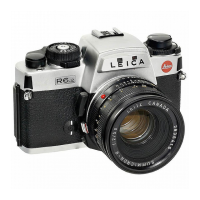
Do you have a question about the Leica R 6.2 and is the answer not in the manual?
| Brand | Leica |
|---|---|
| Model | R 6.2 |
| Category | Digital Camera |
| Language | English |
Detailed list and identification of key external parts of the LEICA R6.2 camera.
Instructions for securely attaching and detaching LEICA R-Lenses to the camera body.
Lists suitable silver oxide and lithium battery cells for the LEICA R6.2 and provides important care instructions.
Instructions for setting the camera's ISO film speed and for safely rewinding and removing exposed film.
Describes the full-field integral exposure metering mode, suitable for subjects with varied brightness and even lighting.
Details the selective exposure metering mode, ideal for subjects with wide brightness ranges where specific detail exposure is critical.
Details the operational range of the LEICA R6.2's exposure meter in different modes.
Explains the exposure meter's working diagram, showing relationships between film speed, brightness, shutter speed, and aperture.
Guide on how to switch on the exposure metering system and select the desired metering mode.
Instructions on how to activate the camera's exposure metering system after mode selection.
Guidance on achieving correct exposure by balancing shutter speed and aperture using viewfinder indicators.
Information on performing exposure meter readings at full aperture with LEICA R-Lenses.
Details on how to meter exposure at working aperture for lenses without automatic diaphragms.
Considerations for time exposures and how the exposure meter's range is affected by various factors.
Explanation of the low-light warning indicators in the viewfinder and their meaning.
Example demonstrating how to use positive override for overexposed subjects.
Example showing how to use negative override for underexposed subjects.
Guide on adjusting the eyepiece diopter for a sharp viewfinder image.
Details on available supplementary correction lenses for eyesight inadequacies.
Description of the flexible eyecup for shielding the eye from stray light and improving focusing.
Explanation of the eyepiece shutter's function to prevent light entry and affect meter readings.
How to use the depth of field lever to check depth of field at working aperture.
Explanation of the depth of field scale on the lens and its use for determining depth of field.
Instructions for setting and using the self-timer, including LED indicators and countdown.
Guide on how to take multiple exposures on a single frame using the camera's controls.
Overview of using electronic flash units with the LEICA R6.2, including system compatibility.
Explanation of through-the-lens (TTL) flash exposure control and its indicators.
How to apply manual override correction with TTL flash-exposure control for varied lighting conditions.
Information on connecting conventional electronic flash units via coaxial socket or hot-shoe.
Description of the standard control layout for LEICA R-Lenses with automatic diaphragms.
Explanation of the automatic spring-back diaphragm feature in most LEICA R-Lenses.
Compatibility of LEICA R- and LEICAFLEX-lenses and accessories with the LEICA R6.2.
Instructions for using LEICA M-Lenses with the LEICA R6.2 via the VISOFLEX adapter.
Details on the Motor Winder R for automatic film transport and shutter cocking, including power requirements.
Information about the Motor Drive R for advanced film transport capabilities, including speed settings and power needs.
Description of the handgrip for improved camera handling with motor units.
Information on the electronic remote-control unit for triggering the shutter, with frame counter and timer functions.
Information on the LEICA FOCOMAT V35 enlarger as a complementary product.
Overview of LEICA P-series projectors for slide presentation.
Highlights of LEICA binoculars, known for their optics and resolution.
Contact information and guidance for maintenance and repairs of the LEICA R6.2.
Technical details on the integral exposure metering system and its measurement range.
Information on the power source for the LEICA R6.2, including battery types and testing.
Description of the viewfinder system, including its pentaprism, screens, and magnification.
Technical details on the film transport mechanisms, including the quick-wind lever and optional motor units.
Specifications for the camera body construction materials and design.
Key physical dimensions and weight of the LEICA R6.2 camera body.